Today is Joe Simon’s birthday, he is now 95 years old. My original plans were to get a picture of Joe on his birthday and post it late today. However when I talked to Joe he remarked that he had told his family he wanted nothing special to happen on his birthday; no party or unexpected visitors. So I decided that taking a picture during my visit might not be a good idea. So in substitution here is Joe with one of his creations taken at the New York Comic Con in 2005.
Tag Archives: Joe
Stan Lee Talking About Joe Simon
I mentioned Stan Lee’s statement about Joe Simon when I wrote about the 2008 New York Comic Con but I recently came across a short clip of it.
This was presented by YouTube user AstonishingTale’s. He also has a couple of other videos from the same Living Legends panel. One is a clip with Jerry Robinson and Stan Lee discussing the most creative individuals they ever meet. As much as I liked Lee’s choice, it was who Robinson praised that I really appreciated.
It’s A Crime, Chapter 7, A Studio With Many Artists
(Justice Traps the Guilty #6 – #8, Headline #33 – #34)
This chapter will cover the Prize crime comics from the period September 1948 until February 1949. Young Romance was also published throughout this period and the first Young Love issue would be cover dated February 1949. Charlie Chan, which featured covers by Jack Kirby and most stories by Carmine Infantino, was also published during this time interval. An important shift seems to have occurred between the material covered here and that from last chapter. Chapter 5 discussed 6 artists with attributions for all the stories. In this chapter there are 10 artists identified but 8 stories remain unattributed so the number of artists was actually higher. The change did not affect Jack Kirby very much, if at all. Jack remains the principal artist; providing all the covers and 6 stories for a total of 77 pages. Kirby supplied all the lead stories and even the illustrations for three text pieces. On the other hand, Bill Draut plays a much more minor roll rendering only 3 stories with 22 pages total. Warren Broderick would do more (4 stories with 30 pages, assuming my attributions are correct). Manny Stallman would tie Draut (3 stories with 22 pages).
There also seems to be a difference between the crime titles and Young Romance during this period. At the same time that Draut’s presence declined in the crime titles he and Kirby were still the main artists for Young Romance. Young Romance #7 (September 1948) to #9 (January 1949) would be drawn by Kirby and Draut alone. Young Romance #10 (March 1949) would also include just one story by artists other then Kirby or Draut (the team of Al Eadeh and John Belfi). This is very different from the multiple artists present in the crime titles. Eventually Simon and Kirby would stop producing crime comics; one of the reasons that I am doing this serial post is to try to determine more precisely when that happened. Simon and Kirby were certainly producing Headline and JTTG during the period covered in this chapter, but the drop of crime stories by Bill Draut may be symptomatic of a change to come.
Because of the number of artists, I am going to bypass some. One to be skipped will be Bill Draut. Draut’s work during this period is pretty much the same as seen previously. Another artist that will be neglected here will be A. C. Hollingsworth. “The Amazing 3 Sinister Salesmen” (JTTG #6, September 1948) will be the last signed work that Hollingsworth would do for Simon and Kirby. So far I have not seen an unsigned work by Alvin so I suspect that Hollingsworth total output for Simon and Kirby was an unremarkable four stories. A surprisingly low number for an artist that Joe Simon still remembers. Finally there are 8 stories that I have not determined an attribution. I presently believe that 4 or 5 different artists are present but I will discuss only one of them.
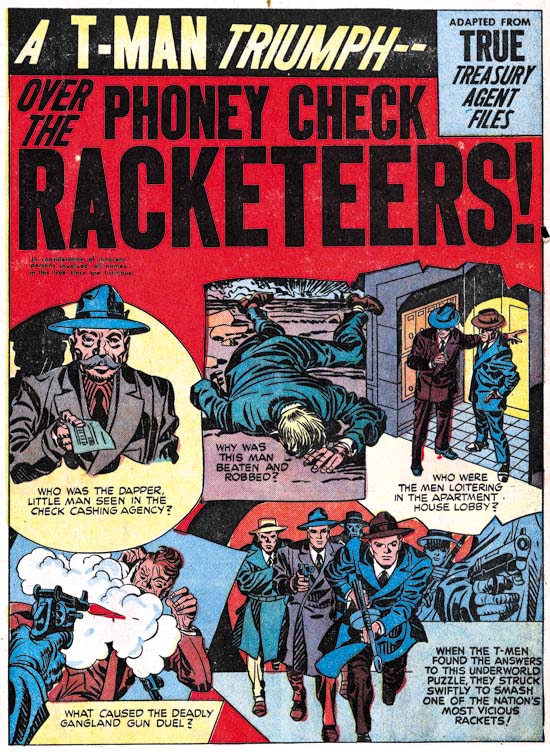
Justice Traps the Guilty #7 (November 1948) “Phony Check Racketeers”, art by Jack Kirby
Most of the lead stories continued to use the motif of a character introducing the story with the speech balloon forming the title. For “Phony Check Racketeers” Simon and Kirby deviated by giving the lead story a splash design they had not previously used for crime comics. The splash actually consists of five vignettes acting as the comic book equivalent of a movie trailer. Four panels ask questions that suggest some of the content of the story while the fifth indicates that the T-Men will find the answers and once again prove that crime does not pay. I do not recall any previous splash that consisted of little more then a series of preview panels but there is some similarity to this splash to one Captain America #9. In any case it is a layout that would rarely be used by Simon and Kirby for their splashes.

Justice Traps the Guilty #6 (September 1948) “The Capture of One-Eye”, splash panel by Jack Kirby, story panels by unidentified artist
I will repeat an observation that I made in my last chapter, Jack Kirby’s crime splashes just no longer have the impact that his early ones had. I find those that Jack was doing at this same time for romance comics much more interesting. However there are occasional exceptions. Kirby certainly provided an interesting splash for “The Capture of One-Eye”. The eye is also by Jack while the story panels, as well as the rest of the story, are by an artist I have not been able to identify. The layout, with its vertical splash and story panel arrangement, is one unusual for Jack. I see no sign of Kirby layouts in this story, so it is possible that the panel layout of the first page was selected by the story artist. But the vertical panel works so well with Jack’s composition that I rather inclined to believe that it was Kirby’s selection despite its otherwise rarity.
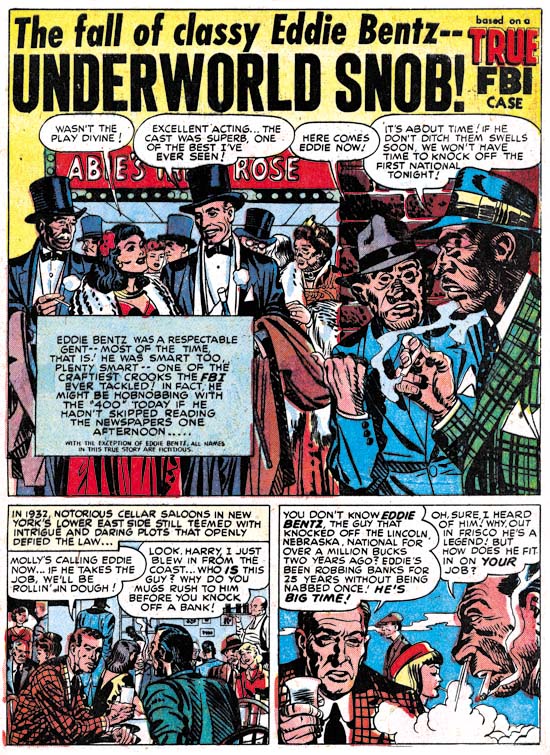
Justice Traps the Guilty #8 (January 1949) “Underworld Snob”, art by Jack Kirby and Warren Broderick
One Kirby crime story stands out from the rest of those of this period. The inker was so heavy handed that it is rather easy to overlook this as one of Kirby pencils. It is very similar to “Mother Said No” (Young Romance #7, September 1948 ). Originally I attributed that inking of that piece questionably to Carmine Infantino. In Chapter 5 I changed my mind and now credit Warren Broderick as the inker. I am now attributing the inking of “Underworld Snob” it Broderick as well. However Joe Simon has described inking of Kirby’s work in the Simon and Kirby studio as being like a production line with different artists helping out. I bring this up because I am not convinced that all the inking was all by Warren. The spotting was done in the typical Studio style inking. More typical then Broderick used when inking “A Gangster Dies” (Headline #31, August 1948) a piece where Warren did a good job of mimicking Kirby’s style.
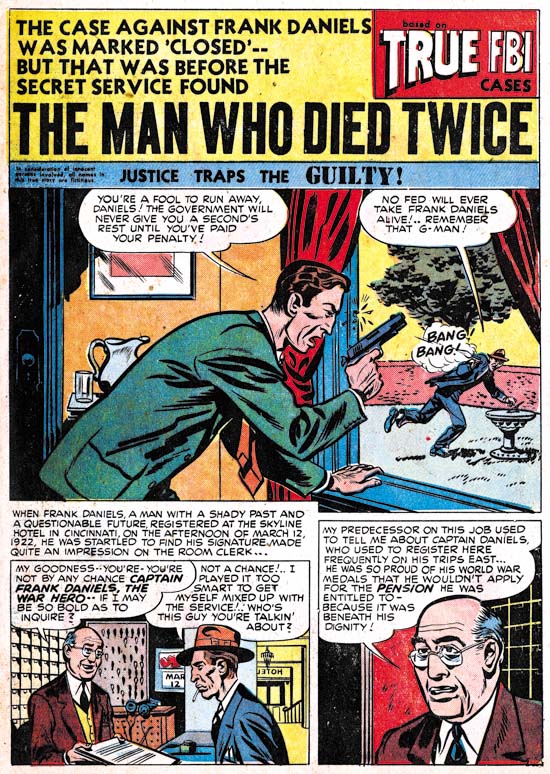
Justice Traps the Guilty #7 (November 1948) “The Man Who Died Twice”, art by Warren Broderick
There are four stories that I here credit to Warren Broderick, this is more then any other artist other then Kirby. But the catch is that I am not complete sure of the identification. The art is simpler then the examples of Broderick from last chapter. Further there is no danger in mistaking any of it for work by Jack Kirby. But the wild eyebrows that Broderick used occur here as well (although not on the example page shown above) and certain facial expressions are found in both groups. Perhaps Broderick is working with another artist; an arrangement that Warren once had with Harry Harrison.
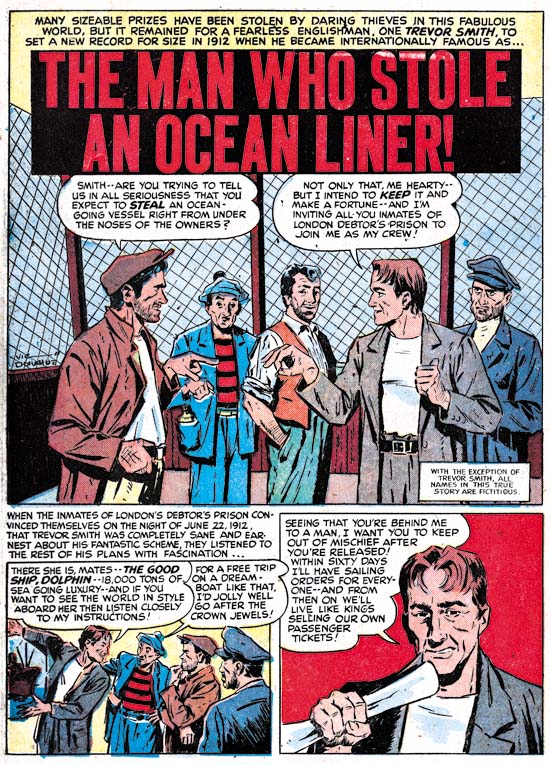
Headline #33 (December 1948) “The Man Who Stole an Ocean Liner”, art by Vic Donahue
“The Mystery of Room 712” (Headline #32, October 1948) was the first work by Vic Donahue for a Simon and Kirby production. Vic also did “The Man Who Stole an Ocean Liner” which I show above. Donahue uses a style that leans toward realism with some panels looking like they were based on photographs. Inking was done with a combination of brush and a pen. We will encounter Donahue in future chapters as well and Vic has already been discussed in the Art of Romance both for work in the western love comics and the more standard romance. As time went on Vic’s work showed less of the careful drawing and fine inking found in his earlier crime stories.

Justice Traps the Guilty #8 (January 1949) “End of a Blackmailer”, art by Manny Stallman
The biggest treat for me in this chapter is Manny Stallman. Stallman is a good graphic story teller with a style that tended toward caricature (or at least for his Simon and Kirby art). Realism is not necessarily a characteristic I look for in comic book art and I find Stallman’s style very appealing. Atlas Tales has a number of examples of his work, but all from a later period (1952 to 1957) and all unsigned. The style is different then Manny used for Simon and Kirby. So different that based on the Atlas material I doubt that I would have recognized Manny’s S&K work had it all been unsigned. But I gather Manny would often change his style. Mark Evanier has a marvelous obituary on Manny Stallman which includes comments by Gil Kane. Kane describes Manny’s inking as “very crude but it worked”. I am very impressed by Stallman’s inking. Not for any show of dexterity, but for the impact the inking provided. Particularly well done are his panels dominated by black such as the last one in the image above.
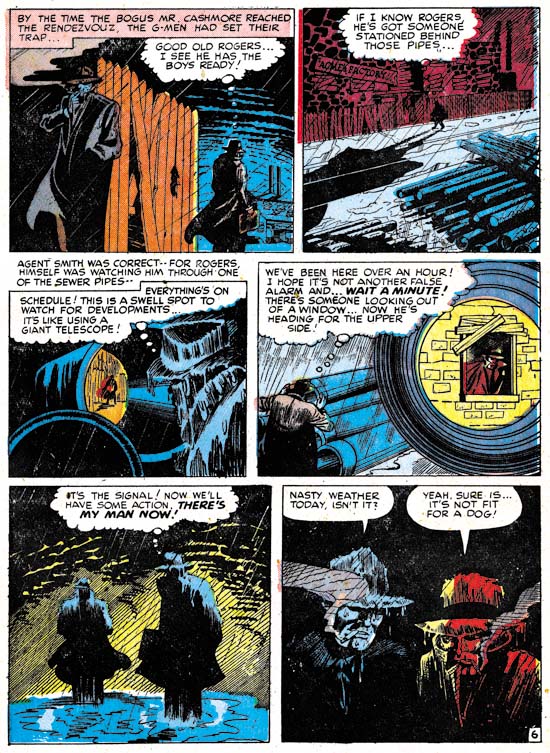
Headline #33 (December 1948) “Underworld Parasite” page 6, art by Manny Stallman
Although he did not seem to use predominately black panels in every story, there are a number of examples I could have selected. Perhaps page 6 “Underworld Parasite” is the best one. The drawing itself is not that exceptional, but the use of blacks makes this nighttime rendezvous very memorable.
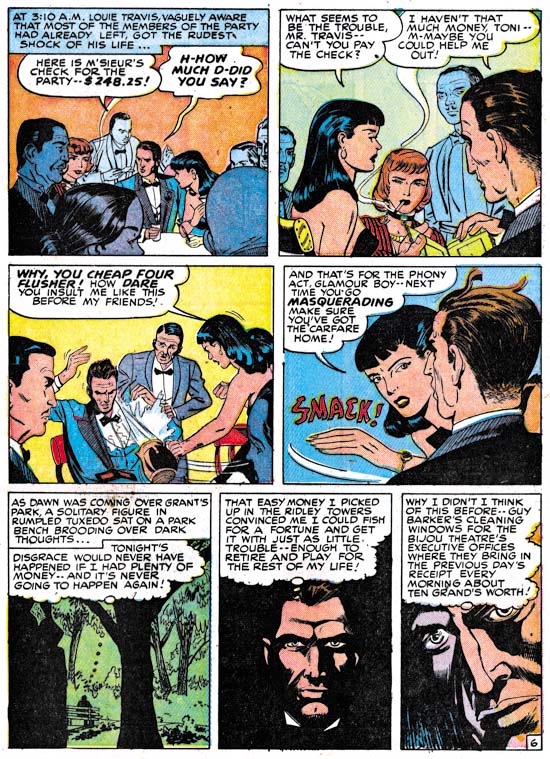
Headline #34 (February 1949) “Twenty Second Story Man” page 6, art by John Guinta and Manny Stallman
In my last installment of The Art of Romance I said I only knew of one work by the team of John Guinta and Manny Stallman for the S&K studio (“The Life of the Party”, Young Love #6, December 1949). I must not have checked my database because there was one other, “Twenty Second Story Man” shown above. (This time I double checked, these two are the only work by Guinta and Stallman in my database). I know little about John Guinta and a Google search did not provide much information. John Guinta’s pencils are distinctive; especially the eyebrows of woman, and it should not be hard to recognize unsigned work, if there is any, in the Simon and Kirby productions. It is interesting to compare Stallman’s inking of Guinta with that on his own pencils. Manny’s use of panels dominated by blacks shows up in “Twenty Second Story Man” as well.
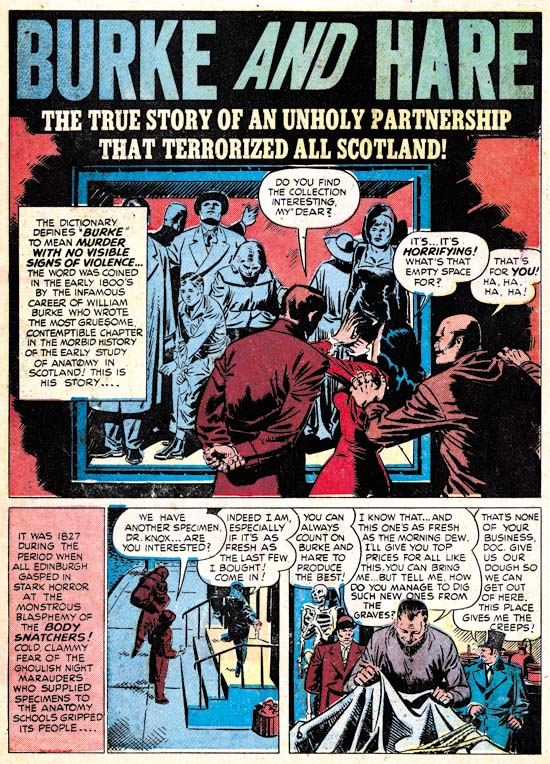
Justice Traps the Guilty #7 (November 1948) “Burke and Hare”, art by H. Colben?
I have included “Burke and Hare” because the artist’s signature is found in the last panel of the story. Unfortunately it is hard to make out the name but my best guess is H. Colben. That, however, does not help much because I have been able to find anything about an artist with that name so perhaps I have misread the signature. Colben is not the greatest of artists but he does have some distinctive features to his style and should be easy to determine whether he produced anything else for Simon and Kirby.

Headline #32 (October 1948) “The Clue of The Horoscope”, art by an unidentified artist
As I mentioned earlier, there are a number of stories that I have not been able to provide attributions. But there are a couple of stories, “Joe Slade, Wild West Jekyll And Hyde Desperado” (JTTG #8, January 1949) and “The Clue of the Horoscope”, by an artist I particularly wish I could identify. This artist uses what I would describe as a severe, sometimes even primitive, caricature style. As is seen often in Simon and Kirby productions, the splash panel shows aspects of the Studio style inking while the rest of the story is not. But there are other traits in the splash inking that deviates from the Studio style and agrees with the story inking. Most importantly the way some of the cloth folds are feathered is normally not an attribute of the Studio style. The picket fence crosshatching (see the Inking Glossary for an explanation of my inking terminology) has a hardness in its application that agrees with the inking found throughout the story. The best explanation for all this seems to be that the artist purposely adopted aspects of the Studio style so as to match better with other stories in the comic. It does seem that splash panels often are done in the Studio style.
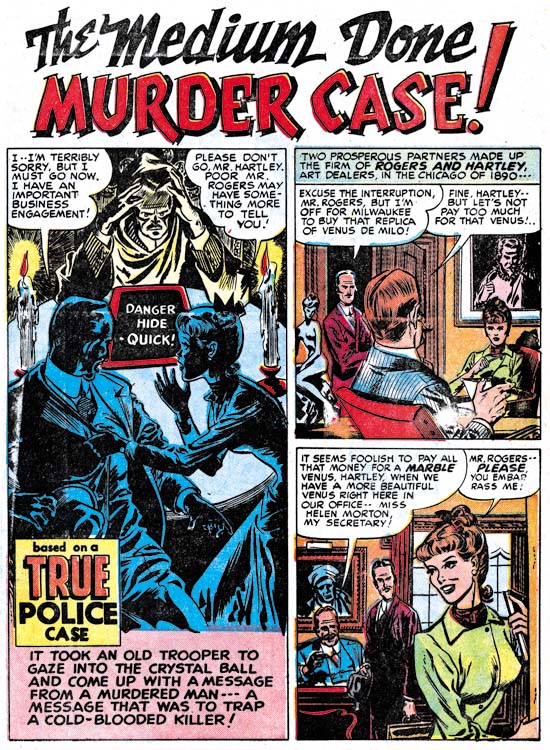
Headline #34 (February 1949) “The Medium Done Murder Case”, art by Leonard Starr
“The Medium Done Murder Case” is the earliest example of work by Leonard Starr for Simon and Kirby productions. It is unsigned but the style closely matches signed work by Starr. The women generally have an elfin look that is characteristic of Starr’s work for Simon and Kirby. Leonard would later produce a good amount of work for the western love titles (covered previously in The Art of Romance, Chapter 7) and some standard romance as well (The Art of Romance, Chapter 5). Starr signed much of his western love work but nothing in Simon and Kirby’s crime titles bears his signature. It will be interesting to see if further unsigned work can be found.
Chapter 1, Promoting Crime
Chapter 2, A Revitalized Title
Chapter 3, Competing Against Themselves
Chapter 4, Crime Gets Real
Chapter 5, Making a Commitment
Chapter 6, Forgotten Artists
Chapter 8, The Chinese Detective
Chapter 9, Not The Same
Chapter 10, The Master and His Protege
Chapter 11, The New Team
Jerry Robinson at the Jack Kirby Tribute Panel
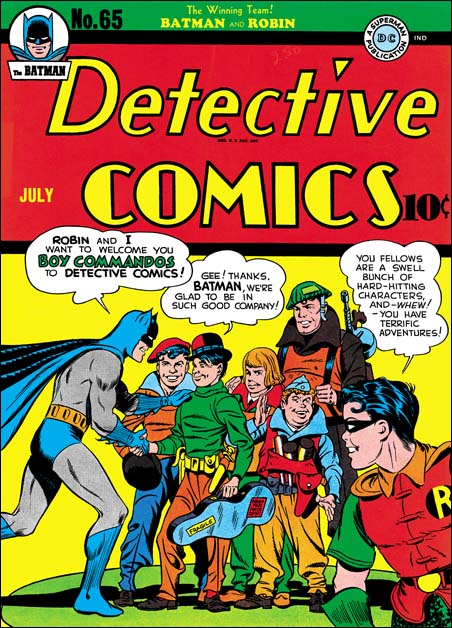
Detective #65 (July 1942), art by Jack Kirby and Jerry Robinson
I mentioned in a previous post a review of the Jack Kirby Tribute Panel that Comic Book Resources has posted (written by Jim MacQuarrie).
At the very end of the article is found:
Jerry Robinson closed the panel by recalling his participation in one of the very few collaborations that Kirby did with anyone but Joe Simon. “The only time Jack collaborated with anyone but Simon on a cover was an issue of “Detective Comics” when the Boy Commandos joined the book. The cover showed Batman and the Boy Commandos shaking hands. I drew Batman and Jack drew the Commandos.”

In Love #1 (September 1954), art by Jack Kirby and John Prentice
While of course Jerry is right about his contributions to the cover of Detective #65, he is not correct about being the only artist, other then Joe Simon, to collaborate on a cover with Jack Kirby. John Prentice, one of the usual suspects of the Simon and Kirby studio, also had that honor. Jack did the foreground couple while John did the two background figures.
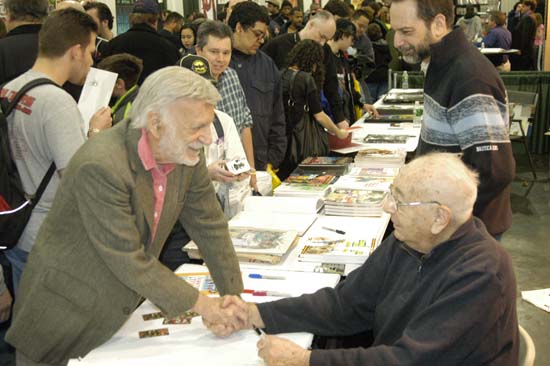
Jerry greeting Joe Simon at the Big Apple Con of 2006
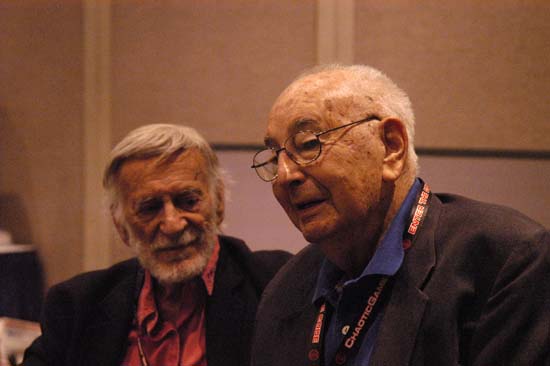
Jerry and Joe at New York ComicCon 2008
It’s A Crime, Chapter 5, Making a Commitment
(Headline #26 – #28, Justice Traps the Guilty #1 – #1)
September 1947 (cover date) was the release of Simon and Kirby’s Young Romance. This marked a milestone for the creative duo. Previously Joe and Jack had not signed any of the work that they provided for publishers Prize or Hillman with the exception of Hillman’s My Date. Starting in September Simon and Kirby signatures would appear not only in Young Romance but in Headline Comics as well. Jack Kirby drew four stories of Headline #26 and three of those were signed. From this point on Simon and Kirby signatures would frequently be found on Kirby’s drawings for Prize Comics. Despite all the work that S&K provided to Hillman, in the end it was Prize that got Joe and Jack’s commitment. Right from the start the crime version of Headline was produced by Simon and Kirby while they never seem to have the same influence with Hillman. Surely whatever deal that Joe and Jack made with Prize must have reflected their greater control over Headline while at Hillman they had remained only marginally better then just work for hire. In the end Simon and Kirby were businessmen and it was all about the money. By early next year Simon and Kirby’s work for Hillman would end.
The crime version of Headline Comics must have been a very successful seller. After just the first four bimonthly issues Prize introduced a new crime title Justice Traps the Guilty. Simon and Kirby produced JTTG as well and there really was no difference in the contents between Headline and JTTG. Since both were bimonthly titles, effectively there would be a crime comic released by Prize each month. There must have been some difficulty because JTTG #2 should have been scheduled for December but was released in January instead; while Headline #28’s normal January release was pushed back to February.
Jack Kirby would still be the main contributor to Headline Comics and the new Justice Traps The Guilty. Jack drew 4 out of 6 stories for Headline #26 (September), but would only draw two stories each for issues #27 (November) and #28 (February). The first issue of Justice Traps the Guilty followed the Simon & Kirby’s modus operandi of starting a title with lots of Kirby; Jack penciled 6 out of the 8 stories. However with the second issue Jack returns to supplying a more modest 2 stories. Still no other artist appeared more often then Jack in these issues.
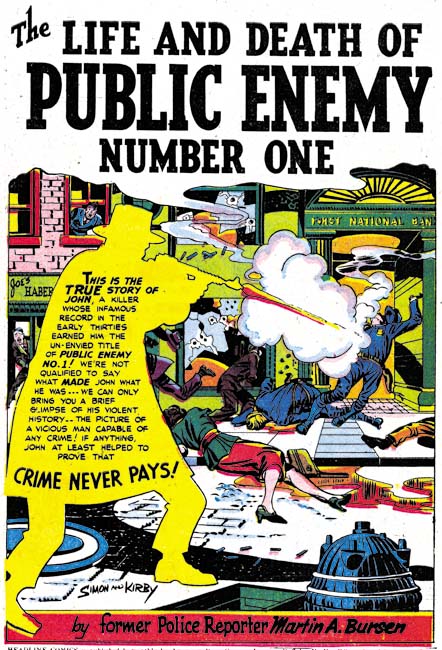
Headline #26 (September 1947) “The Life and Death of Public Enemy Number One”, art by Jack Kirby
The splash for “The Life and Death of Public Enemy Number One” uses a silhouette. There seemed to have been a flurry of the use of this device because we have seen it previously. However it would be pretty much dropped by Simon and Kirby and this may be its last use. While making the overall design of the splash more interesting, the use of silhouette diminished the impact as well.
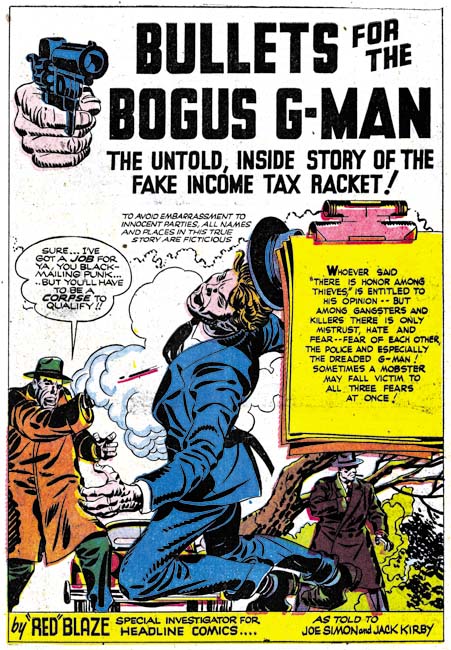
Headline #26 (September 1947) “Bullets for The Bogus G-Man”, art by Jack Kirby
Another device used by Simon and Kirby in the early Prize crime comics was having “Red” (or “Red-Hot”) Blaze introduce the stories. While I suspect that Simon and Kirby found it a useful idea when they were promoting the idea of crime comics to Prize and for the initial in-house advertisements, in the end it just took up story panels that would had been better served for telling the actual story. “Bullets for the Bogus G-Man” may have been the last use of “Red” Blaze and even there he is only mentioned in the caption at the bottom of the splash page and never makes an actual appearance in the story.

Headline #28 (February 1948) “I Worked For the Fence”, art by Jack Kirby
One motif Simon and Kirby sometimes used for the first story was adopted from previous use in Young Romance. That is having a character introducing the story and using the word balloon as the title caption. Simon and Kirby did not use this design technique as frequently in the crime titles as they would in Young Romance but it still was an effective part of their repertoire.
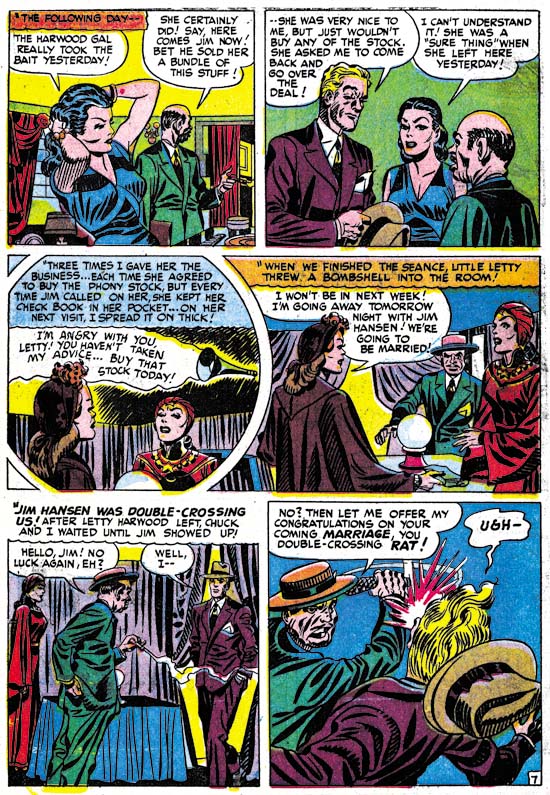
Headline #27 (November 1947) “Spirit Swindlers” page 7, art by Jack Kirby
I have remarked before that circular panels was largely limited to an occasional splash page for the work that Simon and Kirby did for Hillman. For the Prize issues discussed in this chapter, Joe and Jack continued to use circular panels. What was new is that while previously almost all the Prize comic stories used circular panels in Headline #26 to #28 and JTTG #1 and #2 about half of the stories did not use round panels at all. For the stories that still featured circular panels they are used in lower proportions. For Headline #23 to #25 ratios of rounded panels to all the panels was over 16% and in one story reached 20%. Remember for a story done in the standard 6 panels per page, this would work out to an average of a semi-circular panel for each page (although they rarely were distributed so evenly). For Headline #26 to #28 and JTTG #1 and #2, when rounded panels were used they were generally used in the range of 14% to 10%. This is only a small decrease, but it seems to be consistent. In one story (“The True Life Story of Alvin Karpis” it drops to 4%. The last issue covered in this chapter (Headline #28, February 1948) did not have any rounded panels.
I have also been trying to track the evolution of the inking techniques used. Previously in Headline drop strings and abstract arch shadows, typical Studio style mannerisms, had become commonly used. Picket fence crosshatching and shoulder blots were still rare and when found are not typical in execution. (See my Inking Glossary for explanations of the terms I use to describe these techniques). In the last chapter we saw those final typical Studio style techniques show up suddenly in the Hillman crime title. The same thing happened at Prize. The earliest typical picket fence brush work for Prize that I have noticed was in “Spirit Swindlers” (see above image, particularly panels 4 and 6. There seems to be no gradual conversion of previous simple crosshatching to picket fence crosshatching; picket fence just suddenly appears. The picket fence inking shows up elsewhere in the story as well. Not every story in the same issue, however, shows the use of this most distinctive inking. Also note the shoulder blot in panels 1 and 2.
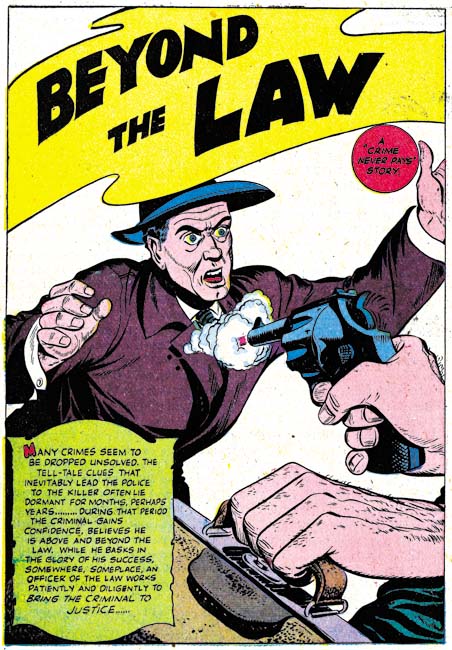
Headline #26 (September 1947) “Beyond the Law”, by unidentified artist
As mentioned above, Kirby drew 4 of the 6 stories for Headline #26. The other two stories (“Test of Death” and “Beyond the Law”) were done by the same artist. I have not been able to identify him but he also did “Murder’s Reward” and “Blind Man’s Death” from Headline #25. Ger Apeldoorn has suggested that it might be Bob McCarty. I am most familiar with McCarty’s work for S&K’s Mainline titles. The Mainline material does not resemble these four stories but that could be explained by the seven years separating the two groups of work. In any case the work in Headline #25 and #26 was done by a talented artist who played an important part in the early Headline issues. After issue #26 the artist stopped providing work to Simon and Kirby.
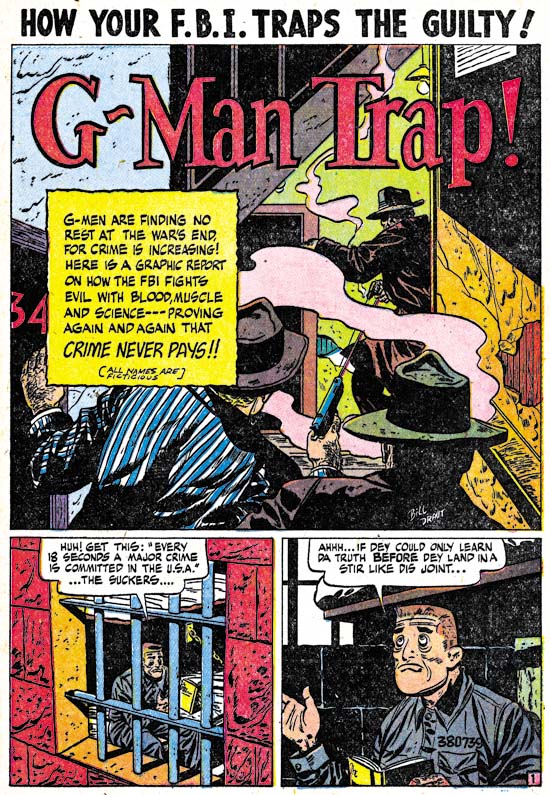
Justice Traps the Guilty #1 (October 1947) “G-Man Trap”, art by Bill Draut
After the mystery artist last appearance in Headline #26, his place as the most important supporting artist (after Kirby) was taken by Bill Draut. Draut’s first returned to the Simon and Kirby productions in Young Romance #1 (September 1947). From that point on Bill would be a mainstay of the S&K studio until its breakup. Draut would provide two stories each issue for Headline #27 and #28 as well as JTTG #1. In those issues Draut’s contributions of stories equal that of Jack Kirby. It is interesting to see Draut’s take on crime since so much of his output for the Simon and Kirby studio was for romance titles. Bill could be surprisingly effective with action and he also did some interesting splashes. The one for “G-Man Trap” is a good example. The use of diagonal elements makes the splash visually stimulating. However, the placement of the gun smoke and the odd pose of the shooter in the background really did not work well and diminishes what should have been an interesting confrontation. Still you have to admire Draut for the attempt made even if it was not completely successful.

Justice Traps the Guilty #1 (October 1947) “Try an FBI Test” page 2, art by Bill Draut
As I have mentioned a number of times in the past, I am convinced that Kirby did not supply layouts for Draut as some experts have suggested. Bill’s means of telling a story and his splash designs (such as the one from “G-Man Trap” shown earlier) are often different from Jack’s. There is one story, “Try an FBI Test”, that might suggest otherwise. Note the use of circular panels. These appear throughout the story and are the same form that Kirby uses. While this might suggest that Kirby did the layouts, I am not convinced. In “Try an FBI Test” the captions and word balloons frequently extend beyond the border of the circular panels which is unlike Kirby’s use where both captions and work balloons invariable are confined within the circular boundary. Nor was there any real change in the way the story is graphically told compared to other work by Draut. I believe Draut has just trying a layout technique that he previously observed Kirby using. Whatever the reason for the use of circular panels, it was a one time occurrence as I do not believe Bill would ever used it again.

Headline #28 (February 1948) “Postage Stamp Swindle”, art by Jerry Robinson and Mort Meskin
Young Romance #3 (January 1948) saw the first appearance of the Jerry Robinson and Mort Meskin team working for the Simon and Kirby studio. “Postage Stamp Swindle” (Headline #28, February 1948) was the first crime work that they did for S&K. As a team, Robinson and Meskin would only work for Joe and Jack for about seven months and provide a total of ten pieces of work. Only two of the stories are signed but the unsigned work is very consistent with those bearing signatures. Jerry and Mort had a preference for splash pages with a vertically dominated splash panel with two story panels also vertically arranged. The first page of “Postage Stamp Swindle” exaggerates that motif by placing the title over the story panels in a caption shaped like a stamp. Otherwise the splash panel usually had the shape of an inverted ‘L’.
I have been assigning the pencils to Jerry and the inks to Mort. This was due to the order that their names appear in their signature. Further the inking does predominately look like Meskin’s. Recently I have been spending some time looking over some of Meskin’s work from 1946 and 1947. I find that the work Robinson and Meskin’s supplied for Simon and Kirby look very much like the early work that Mort did on his own. So much so that I wonder what Robinson’s contribution was? I am tempted to attribute all the early unsigned art for S&K as Meskin alone and only credit the last three stories, two of which are signed, to the Robinson and Meskin team. I have two reasons for not taking that course. One is the still great similarity of the signed and unsigned work. The second is Joe Simon’s story of when Mort came to work for the Simon and Kirby studio as described in his book “The Comic Book Makers”. Joe really makes it sound like that was the first time Mort had worked for them which would not be true if Meskin was solely responsible for the work from 1948.
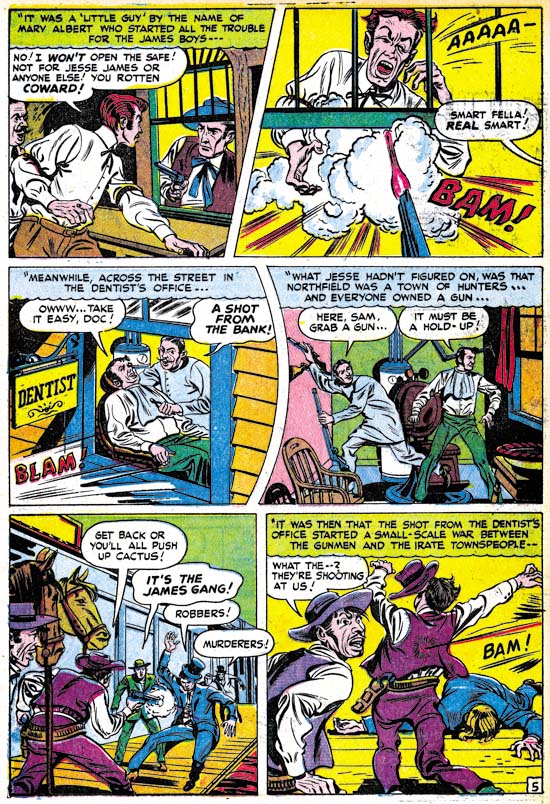
Headline #27 (November 1947) “The Guns of Jesse James” page 5, art by Jack Kirby and an unidentified artist
“The Guns of Jesse James” is one of those stories that at a glance were obviously done by some artist other than Jack Kirby; the drawing is just too crude. There are some places where the art, although still crude, looks like Jack’s style. The second panel in the page above is a good example. This story even uses rounded panels like those that Jack would use for some of his own stories. While it is possible that the artist was trying to mimic Kirby’s techniques, I think it more likely that he is working from rough layouts provided by Jack.

Justice Traps the Guilty #2 (January 1948) “The Killer Thought He Was Satan” page 4, art by an unidentified artist (Jack Kirby layouts?)
The possibility of rough Kirby layouts may also apply to “The Killer Thought He Was Satan”. Note in particular the second panel from page 4 shown above. In many ways the graphic story telling is even more like typical Kirby mannerisms then “The Guns of Jesse James”. Both of these stories come from a period where Kirby’s contributions had diminished and the use of layouts may have been an effort to filling the titles without using too much of Jack’s time.
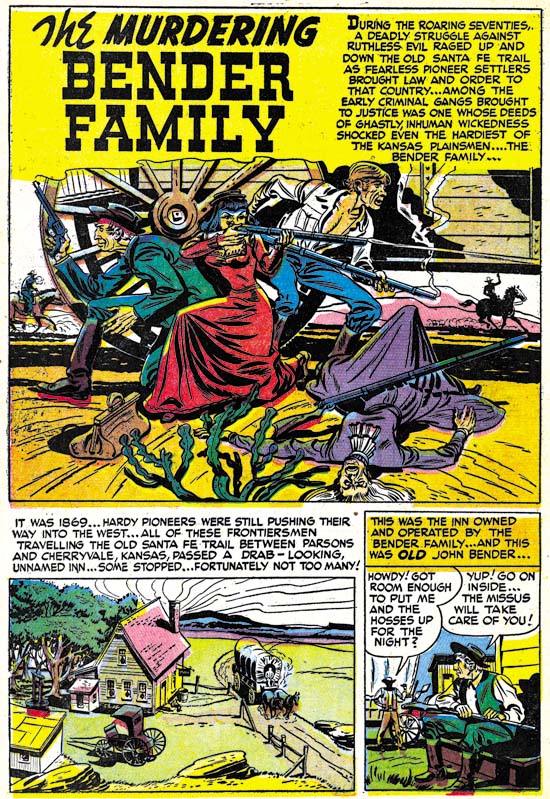
Justice Traps the Guilty #2 (January 1948) “The Murdering Bender Family”, art by an unidentified artist
As I precede in future chapters of this serial post I will certainly not try to cover every unidentified artist in these titles. While I would consider most, if not all, talented some were more deserving of recognition than others. Besides there will be too many artists that I have not identified yet. In these early issues of the crime titles, however, the number of artists appearing is much more limited. So I will close with the splash page of one of mystery artists. I sure wished more of them took advantage of Simon and Kirby’s willingness to allow artists to include their signatures.
Chapter 1, Promoting Crime
Chapter 2, A Revitalized Title
Chapter 3, Competing Against Themselves
Chapter 4, Crime Gets Real
Chapter 6, Forgotten Artists
Chapter 7, A Studio With Many Artists
Chapter 8, The Chinese Detective
Chapter 9, Not The Same
Chapter 10, The Master and His Protege
Chapter 11, The New Team
Art By Joe Simon, Chapter 1, In The Beginning
I disagree with the Kirby Checklist (and most scholars and experts as well) about attribution of some of the work to Jack Kirby. In most of these particular cases I believe the correct assignment would be to Joe Simon. Some of these examples look so obviously Simon to me, that I am amazed at that others cannot see it. In most cases I get no explanation as to why someone attributes something to Jack and not to Joe. As I have discussed previously, comic experts are unwilling or unable to explain their verdicts. There are some few scholars that have tried to give evidence to support their position. But in those cases what I keep hearing is that certain features look like their were done by Kirby. That is all well and good, but what I don’t hear are mentions of features that do not look like the way Simon would do them. In other words these scholars seem to be looking for evidence of Kirby involvement, but are not looking for clues to Simon’s presence. But Joe was a talented artist and through his inking of Kirby’s pencils was very familiar with his style. Joe had the ability and incentive to use things he learned from Jack and even at times to ghost Kirby.
So I would like to do another serial post, this time on art done by Joe Simon before and during the Simon and Kirby collaboration. I doubt I will change many minds about some of these (in my view) misattributions. However I do hope to bring to some a better understanding of Simon’s own style. A similar attempt on the work of Jack Kirby would be a monumental undertaking, there is just so much of it. Joe did not do that much penciling during the years of the S&K studio. So you would think that it would not be that hard to do a fairly detailed and complete analysis. But with Simon I am faced with two problems. The first is that early work by Joe was done during the golden age of comics. These comics are uncommon and generally priced very high. I simply do not have access to all of the comics that some say have work by Joe in them. What I do have for study seems to provide a good idea of Joe’s techniques. A more complete access would certainly be desirable, but I do not think it will change much the view point that I will be presenting here. The second, more serious problem, is the lack of signed work during the period of S&K collaboration. Once they teamed up, work that was signed was done so jointly as Simon and Kirby. No individually signed art was done by either Joe or Jack. So we must look elsewhere for documentation of work by Joe to form the foundation of our analysis.
Joe Simon started his career as a newspaper artist in Rochester, NY. The work I have seen are sport illustrations. These are nicely done in a realistic style, not at all like comic book art. Simon also did a lot of touch up work using an air brush. As Joe described it to me once, if an editor felt a dress was too short in a photograph of a woman, an artist would air brush it longer. Joe became a master of the use of an air brush. But the newspaper Simon worked for shutdown, and he decided to try his luck in New York City.
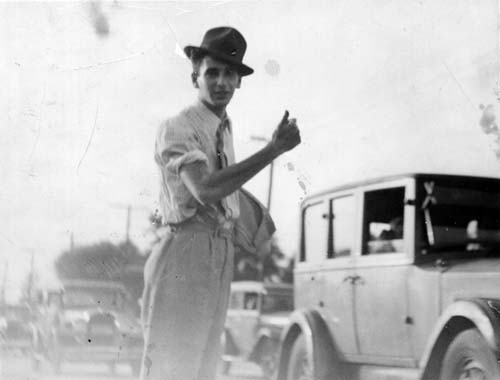
Joe Simon
Joe did find work doing re-touching. But although he was good at it, it was a career he did not want to remain in. Following a suggestion, Joe tried the new comic book industry and entered the Funnies Inc. shop. Although this was a completely new experience for him, he adapted quickly and found it to his liking. In his book “The Comic Book Makers”, Joe says his first job was a seven page western. Unfortunately to my knowledge nobody has located what comic this western was published in. The first published work we do know about was done for different publishers, Lev Gleason, Centaur and Timely, and have cover dates of January 1940. Two covers and two stories, for someone who never did comics before it was an impressive start. But comics was a new industry with opportunities for the those with ambition and talent.
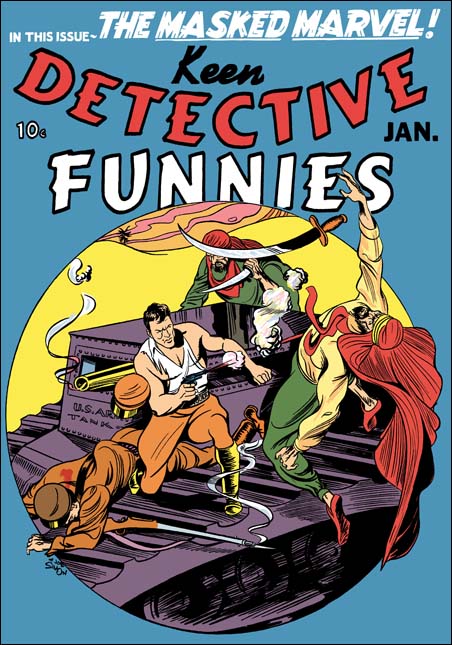
Keen Detective #17 (January 1940) by Joe Simon (signed)
For the Keen Detective cover Joe Simon has chosen a fight atop an American tank in the Arabian desert. An unusual choice since the middle east was not then the center of conflict it is today. Here Joe has trouble depicting the hero. His left arm is not convincing, nor is his left leg. Otherwise the rest of the figures are handled well. Simon’s composition works well with and complements the circular field used. The circular field works so well that I wish I could credit Joe with it. In fact this field was a trade mark of Keen Detective and was used for a number of covers before this one. However most of the artists were unable to use it as effectively as Simon did. Still I believe Joe liked the results and a circular design would reappear in some S&K covers in a couple of years. The inking looks like it was done mainly with brush. To me there really is nothing wrong with the inking. But it seems mainly to be used in deliminating the figures. What spotting there is appears mainly to have been done to provide some form to the tank, it is does not seem to aid the over all design.
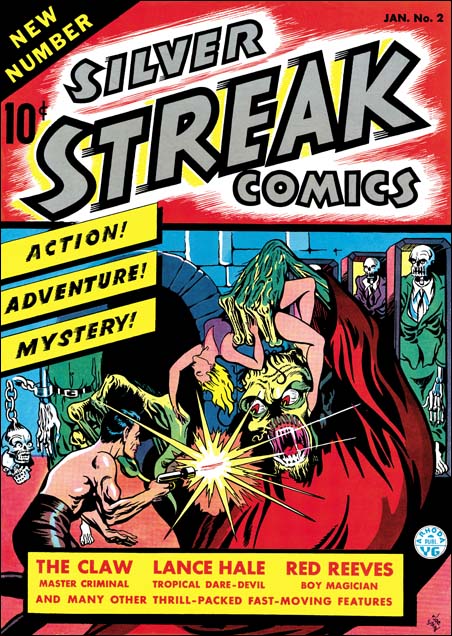
Silver Streak #2 (January 1940) by Joe Simon (signed)
For the cover of Silver Streak #2, Joe depicts the Claw, a villain with his own feature story inside. Although given a monstrous portrayal, the Claw was originally recognizably as a personification of the yellow peril. Being politically correct was not a consideration in those days before the war. But Simon has made the Claw not as an Asian monster, but instead used Frankenstein as a model. It is an exciting cover with corpses in open coffins (zombies?), a scantly dressed damsel in distress and a hero to the rescue. Remember the damsel, we shall see her again. Anatomy is not Joe’s strong point here, he does not even try to be accurate. Simon provides enough muscle lines to convince the viewer that the hero is strong in body as well as strong in character. What Simon does excel at is design, and the composition of the cover is excellent. Inking is done primarily with a brush in a bold manner. The inking is much more effective then in the previous cover.
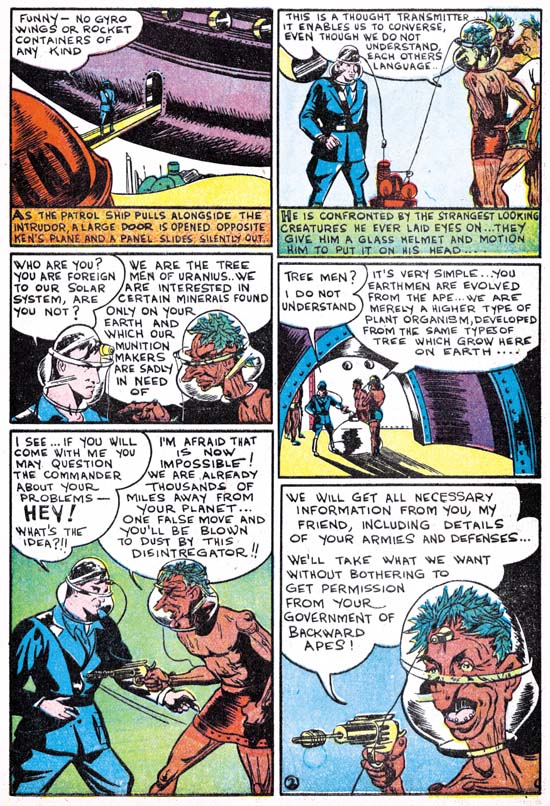
Silver Streak #2 “The Tree Men of Uranus” by Joe Simon (signed)
Joe Simon initiates a new feature, Solar Patrol. Joe liked science fiction, and it was a genre that he would turn to often. Frankly after Joe’s exciting cover work, this example of his story art is a bit of a let down. You can tell he is uncomfortable with the whole aspect of the sequential art. Simon does not seem to be satisfied with a standard panel grid and uses variously sized panels instead. Unfortunately it becomes a bit confusing and Joe sometimes had to add arrows to indicate the proper reading sequence. I suspect his panel layout was an attempt to make it all more interesting. He does not succeed here, but I think it is the forerunner of the irregularly shaped and circular panels that S&K would use in the future.
In his book Joe Simon describes learning how to draw for comic books:
Slits for eyes, unless the character was to register astonishment or horror – and then the eyes become circles. Heavier lines for the eyebrows, raised for bewilderment, slanting down toward the nose for anger. One line for the upper lip. A heavier line, indicating a shadow, constituted the lower lip.
In this story Joe seems to have followed the use of simplicity to a fault. Perhaps because of it he does not seem to be able to make panels as exciting as his covers. Even panels that by their nature should be interesting, such as the space ship destroying the enemy base, come off as rather dull. Another aspect of Joe’s adoption of simplicity is techniques he starts using in the depiction of his figures. Most obvious among them is the way Simon draws eyes. For men viewed at mid-distance Joe uses a single mark to indicate the eye itself and another for the eyebrow. He joins these two marks so that they meet at an angle, sort of like a sideways ‘V’. We will see this typical Simon technique in much of the art he did before teaming up with Jack Kirby. As for women, Simon economical penciling is too extreme leaving them with limited hair strand lines and no real feel of curls. There is a striking difference between how Joe draws the humans, and the more detailed version he provides for the tree men. I suspect that Joe may be swiping the aliens from some unknown source. Even if that is not true, we will meet a related version of the tree men again.
For another story, Simon was asked to make a character based on the use of fire such as done in the Human Torch. This might sound like a recipe for infringement except the publisher was Goodman, he already had the copyrights to the Human Torch. Joe’s response was the creation of the Fiery Mask which appeared in Daring Comics #1. Unfortunately I have no scans for this story. But if you are a Kirby diehard, you may have a copy of Greg Theakston’s “The Complete Jack Kirby, 1917 – 1940” which has a wonderful restoration of this story. Joe did a much better job with this feature then he did on Solar Patrol. Part of the reason is due to the his adding more action and interest to his panels. Greg Theakston gives another important reason by showing that Joe has done a bit of swiping from master artist Hal Foster.
Let me close this chapter with a story Simon told after dinner to Carmine Infantino, and myself. Joe talked about the cover to Red Raven #1 (August 1940). Apparently someone has recently shown that the drawing is a swipe (from Hal Foster again?). Joe grumbled that when it when it was thought to be an original work it was a Kirby, but when now that it is a swipe Simon must have done it. But after he finished this remark Carmine asked “But Joe did you use swipes?”. Joe replied “Of course I used swipes, everyone did”. (Actually the Red Raven cover was penciled by Jack, but I suspect the layout was by Joe, and not because it is a swipe). We will find that not only did Joe use swipes, he re-used them.
Chapter 2, Before Kirby
Chapter 2, Footnote
Chapter 3, Working for the Fox
Chapter 4, Transition
Chapter 4, Footnote
Chapter 5, Side by Side
Chapter 6, Jon Henri
Chapter 7, Glaven
Chapter 8, Off to War
Chapter 9, American Royalty
Chapter 10, A History Lesson
Chapter 11, The Party Is Over
Chapter 12, Covering the Fly
Chapter 13, Wrap Up
Art by Joe Simon, Appendix 1, Champ 22 Confirmed
Art by Joe Simon, Appendix 2, Daring Adventures #12
Art by Joe Simon, Appendix 3, Daring Mystery Comics #3
Art by Joe Simon, Appendix 4, Daring Adventure #16
Art by Joe Simon, Appendix 5, Harvey Hits #12
Art by Joe Simon, Appendix 6, Amazing Man #10
Art by Joe Simon, Appendix 7, The Spirit #12
Art by Joe Simon, Joe Simon as a Newspaper Staff Artist
Joe Simon Checklist
Last update: 1/19/2009
Codes:
s: = signed
a: = signed with alias
&: = signed Simon and Kirby
?: = questionable attribution
r: = reprint
48 Famous Americans (J.C. Penny)
**** 1947 [cover]
**** 1947 48p "individual biographies"
Adventure Is My Career ()
**** 1945 [cover]
**** 1945 32p ""
Adventures of the Fly (Archie)
2 Sept 1959 [cover]
3 Nov 1959 [cover]
4 Jan 1960 [cover]
Alarming Tales (Harvey)
1 Sept 1957 [cover]
2 Nov 1957 [cover]
2 Nov 1957 [contents]
3 Jan 1958 [cover]
4 Mar 1958 [cover]
4 Mar 1958 [contents]
4 Mar 1958 1p "The Feast Of The Rag Dolls"
? 5 Sept 1958 [contents]
Amazing Man ()
s 10 Mar 1940 6p "Ranch Dude"
Black Cat (Harvey)
s 5 Apr 1947 10p "My City Is No More"
6 July 1947 9p "Fear The Story Of A Guilty Conscience!"
7 Sept 1947 10p "Death-Trap De Luxe"
8 Nov 1947 12p "The Madness Of Doctor Altu"
Black Cat Mystic (Harvey)
60 Nov 1957 [cover]
Blue Beetle (Fox)
2 May 1940 [cover]
3 July 1940 [cover]
Blue Bolt (Funnies)
s 1 June 1940 8p "The Human Lighting Streak"
s 2 July 1940 7p "Blue Bolt"
3 Aug 1940 [cover]
s 3 Aug 1940 6p "Blue Bolt"
7 Dec 1940 [cover]
Boy Commandos (National/DC)
& 12 Sept 1945 [cover]
& 12 Sept 1945 3p "Coast Guard Reconnaissance"
Boy Explorers (Harvey)
1 May 1946 12p "Let's Meet His Highness The Duke Of Broadway"
Champ (Harvey)
a 19 June 1942 [cover]
22 Sept 1942 [cover]
Champion (Harvey)
8 June 1940 [cover]
Cockeyed (Hillman)
& 4 Apr 1956 2p "Guys And Dolls"
Daring Adventures (Super Comics)
12 **** 1963 [cover]
15 **** 1964 [cover]
16 **** 1964 [cover]
Daring Mystery (Timely (Marvel))
1 Jan 1940 10p "The Fantastic Thriller of the Walking Corpses "
s 2 Feb 1940 10p "The Phantom Bullet"
a 2 Feb 1940 10p "Trojak the Tiger Man"
s 3 Apr 1940 13p ""
? 5 June 1940 7p "The Devil-Flower"
6 Sept 1940 10p "The Fiery Mask"
Detective Short Stories (Timely)
s (v.2, n5) Aug 1940 2p "Murder Is My Middle Name"
Dick Tracy (Harvey)
129 Nov 129 [cover]
Double-Dare Adventures (Harvey)
1 Dec 1966 [cover]
2 Mar 1967 [cover]
Fantastic (Fox)
s 6 May 1940 [cover]
s 7 June 1940 [cover]
8 July 1940 [cover]
Fighting American (Prize)
6 Feb 1955 8p "Deadly Doolittle"
First Love Illustrated (Harvey)
? 74 Mar 1957 [contents]
Going Steady (Prize)
s 1 (v.3, n3) Jan 1960 [cover]
s 3 (v.3, n5) May 1960 [cover]
5 (v.3, n6) July 1960 [cover]
s 6 (v.4, n1) Sept 1960 [cover]
s 6 (v.4, n1) Sept 1960 2p "Tips for the Teenage Decorator"
Green Hornet (Harvey)
8 Aug 1942 [cover]
r 37 Jan 1948 12p "In This Corner, Kid Adonis"
38 Mar 1948 8p "Affairs Of The Man From Out Of This World"
Harvey Hits (Harvey)
1 Sept 1957 [cover]
1 Sept 1957 1p "The Magic Of The Little White Goddess"
6 Feb 1958 [cover]
6 Feb 1958 [cover]
12 Aug 1958 [cover]
26 Nov 1959 [cover]
? 36 Sept 1960 [cover]
? 48 Sept 1960 [cover]
Hi-School Romance (Harvey)
56 Oct 1956 [contents]
57 Nov 1956 [contents]
58 Dec 1956 [contents]
59 Jan 1957 [contents]
60 Feb 1957 [contents]
61 Mar 1957 [contents]
62 Apr 1957 [contents]
63 May 1957 [contents]
64 June 1957 [contents]
Human Torch, The (Timely / Marvel)
s 2 Fall 1940 10p "The Strange Case of the Bloodless Corpses"
Intimate Confessions (Super Comics)
? 10 **** 1963 [cover]
12 **** 1964 [cover]
18 **** 1964 [cover]
Jigsaw (Harvey)
2 Dec 1966 [cover]
Keen Detective Funnies (Centaur)
s 17 Jan 1940 [cover]
Love and Marriage (Super Comics)
12 **** [cover]
? 12 **** 1964 [cover]
15 **** 1964 [cover]
? 15 **** 1964 [cover]
? 17 **** 1964 [cover]
Mystery Men (Fox)
s 10 May 1940 [cover]
s 11 June 1940 [cover]
12 July 1940 [cover]
Our Friend Ken (Country Art Studio)
**** 8p "Our Friend Ken"- (Political comic)
Pocket (Harvey)
1 Aug 1941 [cover]
2 Sept 1941 [cover]
4 Jan 1942 [cover]
Real Fact (National/DC)
2 May 1946 4p "Combat Photographer"
Romantic Love (Super Comics)
? 10 **** 1963 [cover]
Science (Fox)
s 4 May 1940 [cover]
5 June 1940 [cover]
s 6 July 1940 [cover]
Sick (Prize)
s 1 (v.1, n1) Aug 1960 [cover]
s 38 (v.5, n6) Aug 1965 [cover]
s 41 (v.6, n1) Nov 1965 [cover]
42 (v.6, n2) Feb 1966 [cover]
42 (v.6, n2) Feb 1966 7p "Superfan"
s 44 (v.6, n5) June 1966 [cover]
s 47 (v.6, n7) Sept 1966 [cover]
s 52 (v.7, n4) May 1967 [cover]
s 56 (v.7, n8) Nov 1967 [cover]
s 57 (v.8, n1) Dec 1967 [cover]
s 59 (v.8, n3) Mar 1968 [cover]
s 66 (v.9, n2) Mar 1969 [cover]
s 69 (v.9, n5) Aug 1969 [cover]
s 75 (v.10, n3) Apr 1970 [cover]
s 90 (v.12, n3) June 1972 [cover]
s 92 (v.12, n5) Dec 1972 [cover]
s 93 (v.13, n1) Mar 1973 [cover]
s 94 (v.13, n2) June 1973 [cover]
s 96 (v.13, n4) Dec 1973 [cover]
s 95 (v.13, n3) Sept 1973 [cover]
s 97 (v.14, n1) Mar 1974 [cover]
s 98 (v.14, n2) June 1974 [cover]
s 99 (v.14, n3) Aug 1974 [cover]
s 100 (v.14, n4) Oct 1974 [cover]
s 101 (v.14, n5) Dec 1974 [cover]
s 102 (v.15, n1) Feb 1975 [cover]
s 103 (v.15, n2) Apr 1975 [cover]
s 104 (v.15, n3) June 1975 [cover]
s 105 (v.15, n14)Aug 1975 [cover]
s 106 (v.15, n5) Oct 1975 [cover]
s 107 (v.15, n6) Dec 1975 [cover]
s 108 (v.15, n7) Feb 1976 [cover]
Sick Annual (Prize)
s 1 **** 1967 [cover]
s 13 **** 1973 [cover]
s 14 **** 1974 [cover]
s 15 **** 1975 [cover]
Sick Special (Prize)
s 44 (v.6, n4) May 1966 [cover]
Sick Yearbook (Prize)
s **** 1975 [cover]
Silver Streak (Newsbrook)
s (v.1, n2) Jan 1940 [cover]
s (v.1, n2) Jan 1940 5p "Solar Patrol"
Sole en America (Amigos de Lefkowitz para Alcalde)
**** 8p "Sole en America"- (Political comic)
Speed (Harvey)
a 19 June 1942 [cover]
21 Aug 1942 [cover]
a 22 Sept 1942 [cover]
23 Oct 1942 [cover]
Spirit, The (Super Comics)
**** 1964 [cover]
Spyman (Harvey)
2 Dec 1966 [cover]
3 Feb 1967 [cover]
Star Spangled (National/DC)
& 44 May 1945 [cover]
Strange Planets (Super Comics)
12 **** 1964 [cover]
Stuntman (Harvey)
2 June 1946 12p "The Angel Wore Spurs"
Target (Funnies)
s (v.1, n1) Feb 1940 7p "The Case Of The Black Widow Spider"
s (v.1, n2) Mar 1940 6p "Sabotage"
? (v.1, n4) May 1940 6p "The Counterfeit Lottery Ring"
(v.1, n10) Nov 1940 [cover]
Teen Romances (Super Comics)
? 15 **** 1964 [cover]
? 16 **** 1964 [cover]
? 17 **** 1964 [cover]
The Rockefeller Team (Country Art Studio)
**** 8p "The Rockefeller Team"- (Political comic )
Thrill-O-Rama (Harvey)
1 Oct 1965 [cover]
True 3D (Harvey)
1 Dec 1953 [cover]
1 Dec 1953 1p "splash"
True Bride-To-Be Romances (Harvey)
23 Apr 1957 [contents]
Uncanny Stories (Timely)
(v.1, n1) Apr 1941 1p "The Earth-Stealers"
Unearthly Spectaculars (Harvey)
1 Oct 1965 [cover]
Warfront (Harvey)
29 July 1956 [cover]
? 30 Sept 1957 [cover]
? 34 Sept 1958 [cover]
Weird (Fox)
s 3 June 1940 [cover]
4 July 1940 [cover]
Wonderworld (Fox)
s 13 May 1940 [cover]
s 14 June 1940 [cover]
15 July 1940 [cover]
Young Brides (Prize)
? 19 (v.3, n1) Nov 1954 [cover]
25 (v.4, n1) Nov 1955 [cover]
Young Hearts In Love (Super Comics)
18 **** [cover]
17 Apr 1962 [cover]
Young Love (Prize)
77 (v.4, n2) Aug 1960 [cover]
? 82 (v.5, n1) June 1961 7p "BMOC"
? 82 (v.5, n1) June 1961 6p "Queen Bess"
s 83 (v.5, n2) Aug 1961 [cover]
? 83 (v.5, n2) Aug 1961 6p "The Loneliness"
Young Romance (Prize)
83 (v.9, n5) June 1956 [cover]
s 113 (v.14, n5) Aug 1961 [cover]


